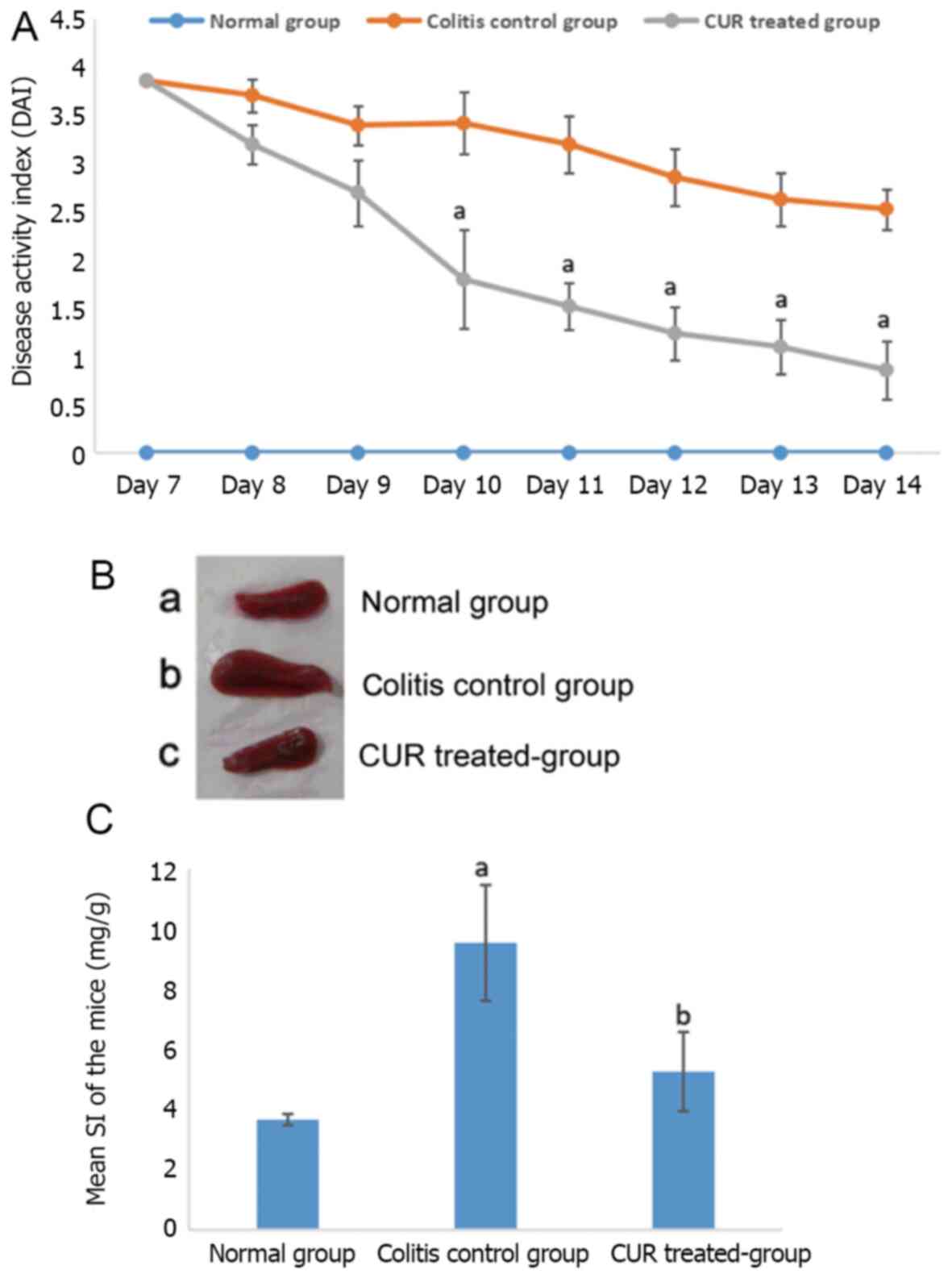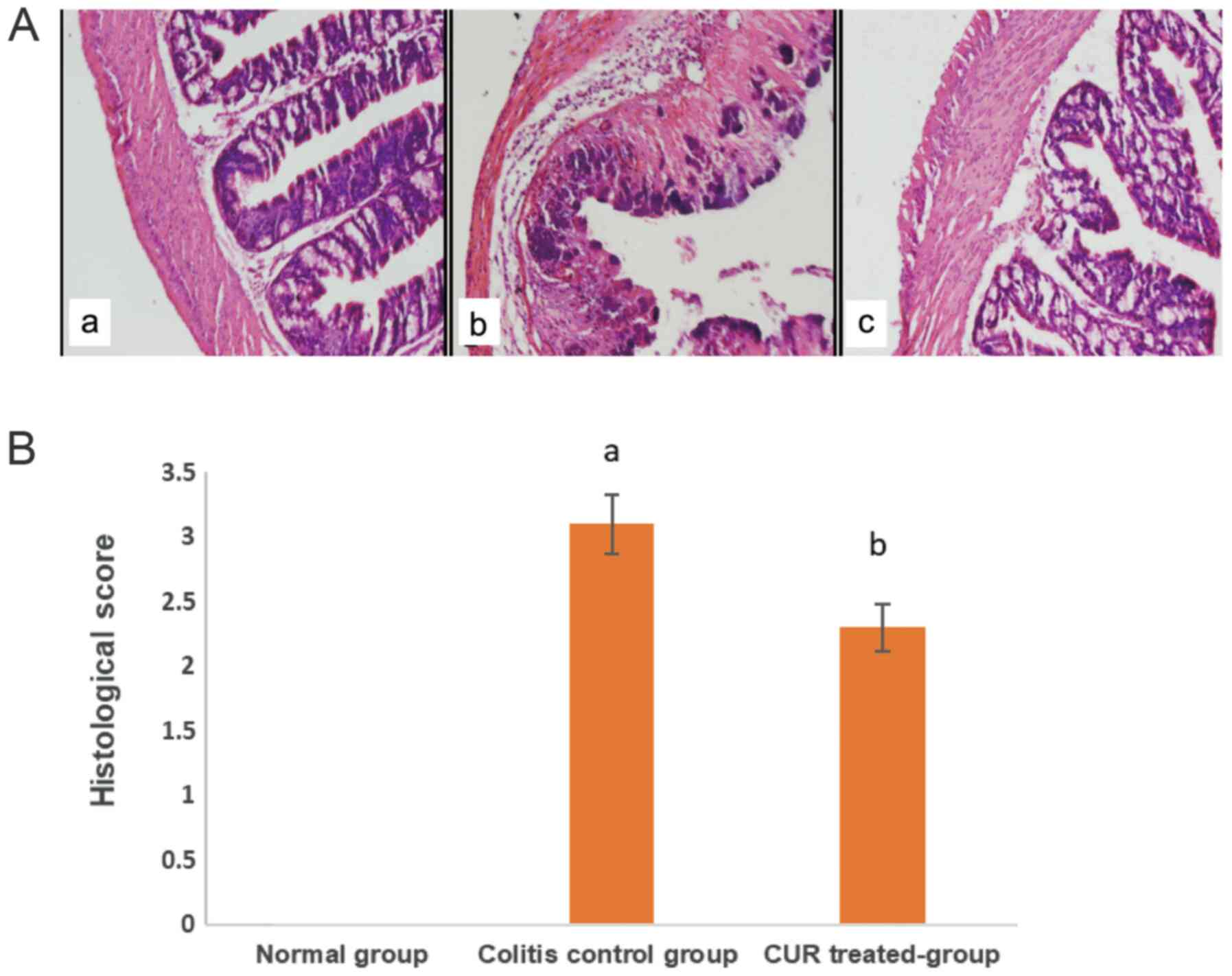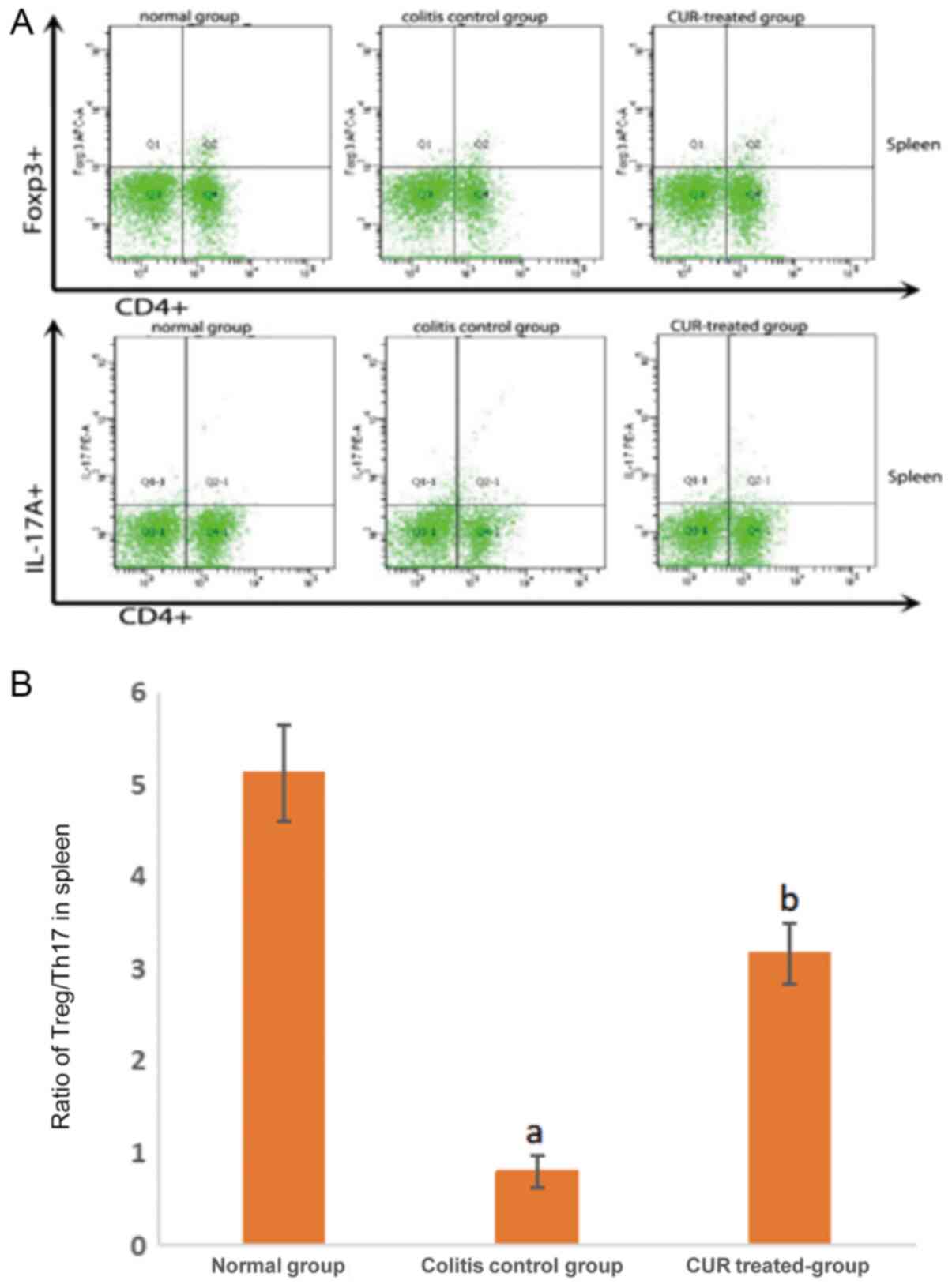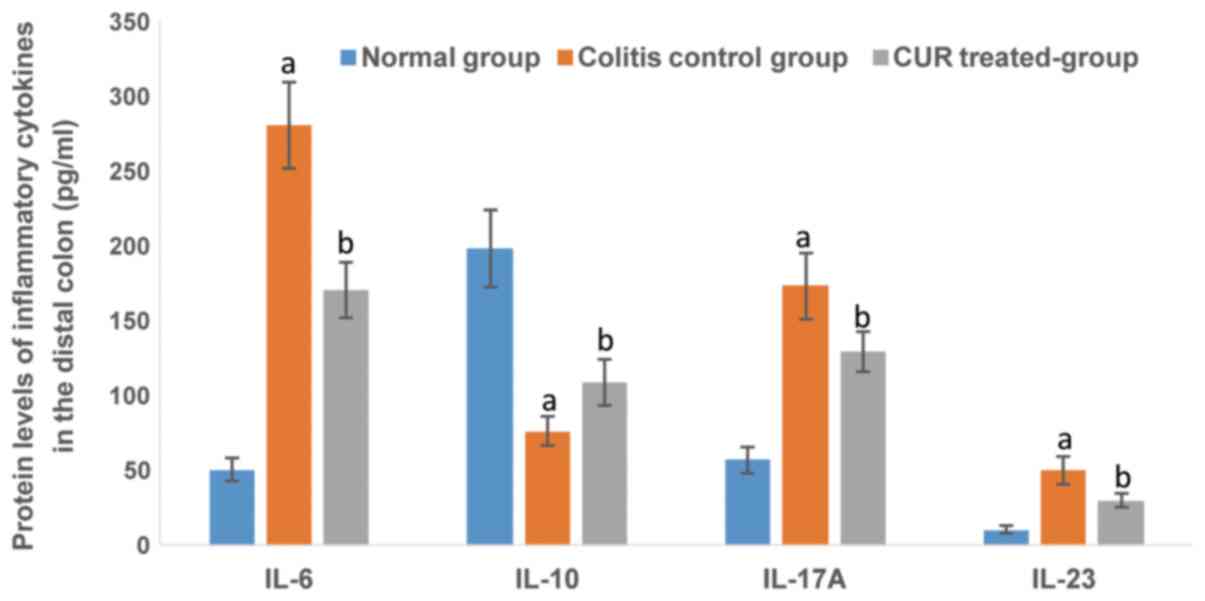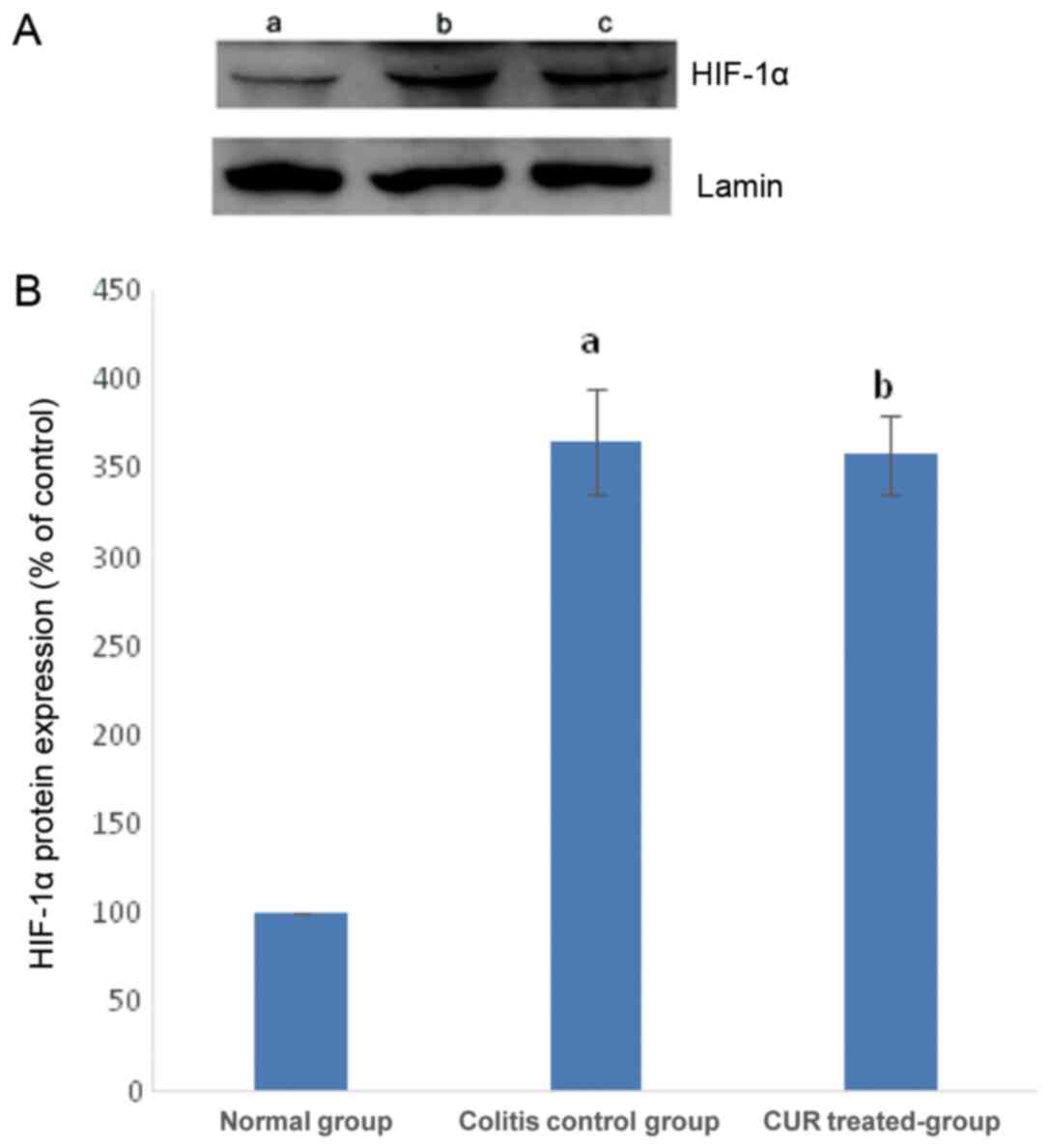Introduction
The incidence of ulcerative colitis (UC) has
recently increased (1). UC is a
chronic, non-specific inflammatory disease that affects the
colorectal tissue of the body (2).
The abnormal immune system in the intestinal mucosa leads to an
imbalance in immune cells and inflammatory cytokines, resulting in
damage to the intestinal tissues (3,4). Th17
cells have been considered to be closely correlated with
inflammatory bowel disease (5), and
studies (6,7) have found that there is abnormal
mucosal immune response in the intestine of UC, which may be
closely related to the imbalance between regulatory T cells (Treg)
and Th17 cells (8). Th17 affects
innate and adaptive immune responses, and participates in the
immunopathological process and prognosis of inflammatory bowel
disease (IBD) by releasing interleukin (IL)-17 and other
inflammatory cytokines (9).
Previous studies have shown that severe Treg/Th17 imbalance in
colitis mice has a clear correlation with the occurrence and
development of colitis (10,11).
The imbalance of Treg/Th17 and cytokines, such as IL-10, IL-17,
IL-6 and IL-23 have a crucial role in the development of UC
(12,13). The IL-23/Th17 pathway also plays an
important role in the activation of Th17 cells and the release of
IL-17 and other inflammatory factors (14). The hypoxia inducible factor (HIF)-1α
signaling pathway plays an important role in the development and
activation of Th17 cells and other inflammatory factors, such as
IL-17. HIF-1α can also bind to forkhead box P3 (Foxp3), leading to
accelerated degradation of Foxp3 and affecting the development and
function of Treg (15). Recently,
the abnormal Treg/Th17 ratio has become one of the possible targets
for IBD therapy (16,17). Curcumin is a non-toxic all-natural
compound extracted from turmeric and has many biological activities
such as anti-inflammation, anti-infection, anti-coagulation and
immune regulation (15,18). It has been reported that curcumin
has a good therapeutic effect on experimental colitis in mice and
can alleviate intestinal inflammation. It participates in
anti-inflammatory, anti-oxidation and other protective effects by
reducing the concentration of nitric oxide, myeloperoxidase and
tumor necrosis factor (TNF)-α, and inhibiting the activation of
NF-κB. However, its therapeutic mechanism in UC remains to be
elucidated (8,19,20).
Through animal experiments, the therapeutic effect of curcumin on
mice with colitis was studied at the histopathological, cytological
and molecular levels, with the objective of revealing the possible
mechanism of curcumin on mice with colitis and providing clinical
treatment ideas. The results of the present study demonstrated that
oral administration of curcumin to dextran sulfate sodium
(DSS)-treated mice could inhibit the intestinal inflammation, and
increase the levels of anti-inflammatory cytokines IL-10 by
regulating the balance of Treg/Th17, while reducing the
concentration of proinflammatory cytokines IL-23, IL-17, and IL-6.
It achieved therapeutic effect through the inhibition of the
IL-23/Th17 pathway (but possibly not the HIF-1α signaling
pathway).
Materials and methods
Experimental animal and treatment
SPF grade BALB/c male mice (6–7 weeks old, weight
22–26 g, n=36; Laboratory Animal Center of Southern Medical
University, certificate number: SCXK Guangdong, China) were reared
in a clean animal room. The temperature was 22–25°C and the
relative humidity was ~55%. The environment was a 12-h light/dark
cycle. Water was given as required and mice were given free access
to food. DSS (average molecular weight 5,000; FUJIFILM Wako Pure
Chemical Corporation) was formulated as 5% solution using sterile
distilled water. Curcumin was purchased from Guangzhou QiYun
Biotechnology Co., Ltd., (purity ≥98.5%). The mice were fed
adaptively for one week and randomly divided into three groups with
12 in each group: Normal group, Colitis control group and Curcumin
100 mg/kg.d treatment group (CUR group). The Normal group was given
sterile distilled water for 14 days. The Colitis group and the CUR
group were given 5% DSS for 7 days. Once the model was established,
they were given distilled water for 7 days. On the 8th day, mice in
the Normal group and the Colitis group were given 0.2 ml of 0.5%
ethanol per day for 7 days, while mice in the CUR group were given
(via gavage) the dose of curcumin 100 mg/kg.d in 0.2 ml of 0.5%
ethanol for 7 days. All experiments on animals were approved by the
Experimental Animal Ethics Committee of Southern Medical
University.
Evaluation of experimental colitis in
mice
Mouse daily disease activity index (DAI) was
recorded according to the Murthy scoring system (21). The scoring criteria are shown in
Table I. DAI = (weight loss rate,
stool viscosity, and total score of invisible/visible bloody
stools)/3). After the mice were sacrificed, the spleen was
dissected and the blood on the spleen surface was washed with
physiological saline, blotted, and weighed. Spleen weight (mg)/body
weight (g) indicates spleen index (SI) (22).
 | Table I.Murthy scoring system. |
Table I.
Murthy scoring system.
| Score | Weight loss
rate | Stool
viscosity | Invisible/visible
bloody stools |
|---|
| 0 | (−) | Normal (Granular,
shaped) | Normal |
| 1 | 1–5% |
|
|
| 2 | 6–10% | Soft (paste, no
adhesion to the anus) | Occult blood
(+) |
| 3 | 11–15% |
|
|
| 4 | >15% | Diarrhea (water
sample, adhesion to the anus) | Bloody stools |
Histopathology evaluation of mouse
colon
Fresh colon tissue (without cecum) of each
experimental group was collected and immediately placed in 10%
formaldehyde. After fixing at room temperature for 48 h, the
tissues were dehydrated using an ascending alcohol series at room
temperature: 30% ethanol for 40 min, 50% ethanol for 40 min, 70%
ethanol for 30 min, 80% ethanol for 30 min, 90% ethanol for 30 min,
95% ethanol for 30 min, 95% ethanol for 30 min, 100% ethanol for 20
min and 100% ethanol for 20 min. Subsequently, the tissue sections
were cut into 5-µm thick sections and heated at 60°C for 55 min.
Then the tissues sections were embedded in paraffin and hematoxylin
and eosin (H&E) staining was performed as follows: Hematoxylin
for 10 min at room temperature and eosin for 2 min at room
temperature All tissue sections were observed under a BX-51 light
microscope (Olympus Corporation; magnification, ×200).
Flow cytometry detection of Treg/Th17
cells
The spleen of the mouse was removed from the laminar
flow cabinet, and the appropriate amount of spleen tissue was
taken. Subsequently, 5 ml mouse lymphocyte separation solution was
added to separate the lymphocytes, and the number of lymphocytes
was adjusted to 2×106/tube. Samples were prepared
according to the manufacturer's protocol of Th17/Treg kit (BD
Biosciences). Lymphocytes were stimulated with 50 ng/ml phorbol
12-myristate 13-acetate (PMA; Sigma-Aldrich; Merck KGaA), 1 µg/ml
ionomycin (Sigma-Aldrich; Merck KGaA) and appropriate concentration
of Monensin (BD Biosciences) for 5 h. Cells were collected and
incubated at room temperature for 30 min with 20 µl flow antibody
in each tube after staining, fixation, membrane breaking and other
steps. The main flow antibodies included mouse CD4-PerCP-Cy5.5,
IL-17A-PE, and Alexa Fluor 647-FoxP3. A negative control group was
also included. Samples were analyzed by flow cytometry using a BD
FACSCalibur flow cytometer (BD Biosciences) and FACStation software
(version FACS101; BD Biosciences).
ELISA assay for cytokine
expression
A total of 50 mg of mouse colon tissue was collected
and an appropriate amount of pre-cooled saline was added. Following
homogenization with a glass homogenizer on ice, it was centrifuged
at low temperature, and the supernatant was collected for
quantification of the protein with Nanodrop 2000 (Thermo Fisher
Scientific, Inc.). The concentrations of IL-6 (cat. no. DKW12-2060;
Dakewe Biotech Co., Ltd.), IL-10 (DKW12-2100; Dakewe Biotech Co.,
Ltd.), IL-17 (DKW12-2170; Dakewe Biotech Co., Ltd.), and IL-23
(cat. no. M2300; R&D Systems, Inc.) in the intestine of mice
were measured in strict accordance with the ELISA kit
instructions.
Western blot analysis
A total of 100 mg of colon tissue was taken, and the
nuclear protein was extracted using the NE-PER™ Nuclear and
Cytoplasmic Extraction Reagents kit (Pierce; Thermo Fisher
Scientific, Inc.), protease and phosphatase inhibitors were added.
Protein quantification was performed by using Nanodrop 2000
quantitative analyzer (Thermo Fisher Scientific, Inc.) and the BCA
method. An appropriate amount of loading buffer was added to adjust
to the same concentration. Then 10% protein electrophoresis
separation gel and 5% aminated gel were prepared, and 30 µg nuclear
protein was sampled. After the electrical conversion, the PVDF
membrane was removed and blocked in 5% skimmed milk powder/TBST
solution (0.05% Tween-20) for 1 h at room temperature. The samples
were separated by electrophoresis, followed by membrane transfer,
blocking, primary and secondary antibodies incubation, ECL imaging
(Thermo Fisher Scientific, Inc.), and analysis. The primary
antibodies were anti-mouse HIF-1α (cat. no. 36169S; 1:200; Cell
Signaling Technology, Inc.) and Lamin (cat. no. ABP0099; 1:1,500
dilution; Abbkine Scientific Co., Ltd.), and the incubation was at
4°C overnight. The secondary antibodies for horseradish peroxidase
labeled goat anti mouse (cat. no. 79233; 1:1,500 dilution, OriGene
Technologies, Inc.) incubated for 1 h at room temperature. Quantity
One software (v1-D; Bio-Rad Laboratories, Inc.) was used to
calculate the relative grayscale value with Lamin as the reference
protein. SPSS v13.0 statistical software (SPSS, Inc.) was used for
statistical analysis.
Statistical analysis
The experimental data were all expressed as mean ±
standard deviation. All experimental data were analyzed using SPSS
v13.0 statistical software (SPSS, Inc.). One-way analysis of
variance was used to analyze the differences between groups. S-N-K
(Student-Newman-Keuls, q test) was selected to compare the mean of
multiple samples. P<0.05 was considered to indicate a
statistically significant difference.
Results
DAI and SI in mice
No animal died during the experiment. The Normal
group score was 0. Colitis group and CUR group demonstrated
umbelliferous bloody stool, weight loss, and activity decreased in
the first 7 d after administration of 5% DSS. As shown in Fig. 1A, compared with the Colitis group,
the DAI score was significantly lower in the CUR group on the 10 to
14th day (P<0.05). As shown in Fig.
1B and C, the spleen was significantly enlarged in the Colitis
group, while the CUR group spleen decreased significantly and SI
decreased compared with the Colitis group (F=71.85, P<0.05).
Mucosal inflammation
As shown in Fig. 2,
compared with the Normal group (Fig.
2A-a), the Colitis group (Fig.
2A-b) clearly demonstrated an acute inflammatory response with
mucosal erosion, congestion, edema, reduction of crypts and
infiltration of inflammatory cells such as neutrophils. Compared
with the Colitis group, mucosal inflammatory cell infiltration,
erosion and edema in the CUR group (Fig. 2A-c) were significantly improved.
Treg/Th17 cell ratios
As shown in Fig. 3,
compared with the Normal group, the ratio of CD4+IL-17+(Th17)/CD4+
lymphocytes was significantly increased in the Colitis group, The
Treg/Th17 ratio was the lowest (P<0.05). Compared with the
Colitis group, Th17 lymphocytes in the CUR group were significantly
decreased, and the Treg/Th17 ratio was significantly increased with
the Colitis group (F=30.67, P<0.05).
Alterations to cytokine levels
As shown in Fig. 4,
compared with the Normal group, the levels of cytokines IL-6,
IL-17, and IL-23 in the colon of mice from the Colitis group were
significantly increased, while the IL-10 cytokine level was
significantly decreased (F=67.96, P<0.05). Compared with the
Colitis group, the IL-6, IL-17 and IL-23 in the colon of the CUR
group were significantly decreased, while IL-10 was significantly
elevated (F=21.36, P<0.05).
Alterations to HIF-1α protein
As shown in Fig. 5,
compared with the Colitis group and the CUR group, the expression
of HIF-1α in the colon tissue of the normal group was significantly
decreased (F=52.18, P<0.05). The expression of the nuclear
protein HIF-1α in the colon mucosa in the Colitis group and the CUR
group was significantly different (F=12.35, P<0.05).
Discussion
The present study observed increasing DAI and SI and
severe mucosa erosion in colitis mice, which is similar to the
symptoms of humans UC. After 7 days of curcumin treatment in
experimental colitis mice, DAI and SI were significantly decreased,
and colonic mucosal inflammation was significantly improved,
suggesting that curcumin has a good therapeutic effect on mice with
colitis. Previous studies have achieved similar therapeutic effects
on colitis mice (23–25). One of the problems with curcumin in
the treatment of colitis is low gastrointestinal absorption,
however, IBD is a special case because curcumin does not need to be
absorbed through the gastrointestinal tract to trigger a systemic
therapeutic effect, but rather serves a therapeutic role through
direct intestinal contact. Curcumin can significantly control the
symptoms of systemic disease and intestinal inflammation in colitis
mice by improving the DAI and intestinal pathology of colitis mice.
The effect of curcumin on the spleen of mice attracted our
attention, and thus the underlying immune mechanisms that are
associated with the therapeutic effect of curcumin were further
explored.
It was demonstrated that the CUR group had more
significant improvement in DAI and SI compared with the colitis
group. The ratio of Th17 cells increased significantly in splenic
lymphocytes of colitis mice, suggesting that there was a serious
imbalance in Treg/Th17 ratio in colitis. DSS-induced colitis mice
experienced a disruption in Treg/Th17 balance, which led to
intestinal immune disorders, one of the key factors for the
formation and progression of colitis. It was thus speculated that
that the spleen serves as an important immune organ and that DSS
can induce immunological disorders in colitis mice and cause
compensatory enlargement of the spleen. The present study further
confirmed that there was a significant Treg/Th17 imbalance in the
splenic lymphocytes of mice with colitis, which is consistent with
human UC. Th17-related cytokines IL-6, IL-17 and IL-23 in mice with
colitis was also increased, while Treg-related cytokine IL-10 was
significantly decreased.
It was speculated that there were multiple
mechanisms that could mediate the therapeutic effect of curcumin on
colitis. First, the imbalance of Treg/Th17 occurs in a variety of
inflammatory and autoimmune diseases. The present study confirmed
that curcumin primarily regulates Treg/Th17 rebalance by
downregulating CD4+IL-17+Th17 cells (26,27).
Therefore, it was hypothesized that one of the mechanisms for the
therapeutic effect of curcumin in the treatment of IBD is to
regulate the re-balance of Treg/Th17. The experiments also revealed
that the mechanism of curcumin in regulating Treg/Th17 re-balance
may be through the inhibition of the IL-23/Th17 pathway (but
possibly not the HIF-1α signaling pathway) to downregulate of Th17.
The present study demonstrated that curcumin can significantly
downregulate Th17 cells. In addition, the expression of IL-23 in
intestinal tissue was significantly decreased in CUR group.
Therefore, it is suggested that the main mechanism of curcumin
regulation of Treg/Th17 rebalance is to inhibit the IL-23/Th17
pathway. It has also been shown by previous studies that the
IL-23/Th17 pathway is closely related to the development and
activation of Th17 cells, and thus is associated with various
diseases such as chronic inflammatory diseases and immune diseases,
including rheumatoid arthritis, psoriasis and IBD (28–30).
However, studies have suggested that local tissue hypoxia induces
HIF-1α synthesis, promotes its entry into the nucleus to exert
biological functions, upregulates and activates Th17, and
simultaneously promotes Foxp3 binding (leading to its ubiquitin and
degradation) and downregulates and inhibits Treg (31,32).
The present study found that curcumin produced no significant
downregulation of the colon nuclear protein HIF-1α. Thus, it is
hypothesized that CUR may not participate in regulating cell
balance by inhibiting the HIF-1α signaling pathway.
The present study demonstrated that the
anti-inflammatory cytokine IL-10 in the CUR treatment group was
elevated, and the proinflammatory cytokines IL-6, IL-17, and IL-23
were decreased. Therefore, maintaining the re-equilibration of
cytokines serves an important role in curcumin treatment of IBD.
IL-10 plays a negative regulatory role in cellular immunity. It can
inhibit the antigen presentation and downregulate the transcription
and secretion of IL-1β, IL-6 and TNF-α and other inflammatory
factors in T cells and macrophages. Ultimately, it inhibits T
cell-mediated immune response and thus improves UC intestinal
inflammation (4). Curcumin serves
an anti-inflammatory role by elevating the level of IL-10 and
reducing pro-inflammatory cytokines. It was speculated that
curcumin promotes the proliferation of antigen-specific effector
cells by modulating the interaction between immune cells through
the regulation of multiple cytokines, and thus improves the local
intestinal or systemic inflammatory response and balances immune
disorders in mice with colitis (33,34).
Curcumin is an all-natural compound extracted from
plants. It has many biological activities including
anti-inflammatory, anti-infective and immune-regulating, and it
protects the intestinal mucosa and repairs the function of
intestinal tissue (35,36). Other similar studies have shown that
in the DSS-induced colitis model, curcumin is found to
significantly improve intestinal inflammation, repair the
intestinal mucosa and inhibit the expression of TNF-α and p38MAPK
(23,24).
Curcumin itself has anti-inflammatory and
anti-infective effects. By inhibiting production of leukocyte
eicosanoid and related inflammatory cytokines, Treg/Th17 disorder
is balanced. Through negative feedback regulation of its own immune
and anti-inflammatory system, it further prevented the inflammatory
cascade amplification, which serves a crucial role in the recovery
of UC. At the same time, curcumin can reduce and inhibit the
exudation of neutrophils and macrophages, regulate intestinal
immune disorders, reduce intestinal endothelial cell swelling and
increase permeability, which further reduces intestinal
inflammation (4,37).
Therefore, the present study suggested that the
mechanism of curcumin in treating IBD may be through downregulating
the proportion of Th17 cells to regulate the re-equilibration of
Treg/Th17 and Th17-related cytokines. Curcumin can significantly
decrease the DAI and SI of the mice with colitis. It can regulate
the re-equilibration of Treg/Th17 by inhibiting the IL-23/Th17
pathway, downregulating IL-6, IL-17, IL-23 and upregulating
anti-inflammatory cytokine IL-10. Curcumin, as a good all-natural
drug for the treatment of IBD, possesses good prospects in clinical
application.
Acknowledgements
The authors would like to thank Dr De-Feng Li, Dr
Yao Jun and Dr Wang Lisheng (all Department of Gastroenterology,
Jinan University of Second Clinical Medical Sciences, Shenzen
Municipal People's Hospital, Shenzhen, Guangdong) for providing
project funding support and revising the manuscript.
Funding
The study was supported by Three Engineering
Training Funds in Shenzhen (grant no. SYLY201718) and Technical
Research and Development Project of Shenzhen (grant nos.
JCYJ20170307100538697, JCYJ20150403101028164, JCYJ20170307100911479
and JCYJ20160429174927286).
Availability of data and materials
The datasets used and/or analyzed during the present
study are available from the corresponding author on reasonable
request.
Authors' contributions
CW designed the study and wrote the manuscript. JW
and DL were laboratory personnel; these authors participated in
part of the experimental process, guided part of the experimental
process design and data analysis, and modified the paper. FX, BW,
ML, ZY and HJ performed the histological assessments and
evaluations. TL, QT, YL, DZ and ZX performed the flow cytometry and
proteomics experiments. LW and JY were responsible for designing
the project, guiding the experimental process, revising the paper
and providing scientific research funding support. All authors read
and approved the final manuscript.
Ethics approval and consent to
participate
All experiments on animals were approved by the
Experimental Animal Ethics Committee of Southern Medical
University, China.
Patient consent for publication
Not applicable.
Competing interests
The authors declare that they have no competing
interests.
References
|
1
|
Ng SC, Shi HY, Hamidi N, Underwood FE,
Tang W, Benchimol EI, Panaccione R, Ghosh S, Wu JCY, Chan FKL, et
al: Worldwide incidence and prevalence of inflammatory bowel
disease in the 21st century: A systematic review of
population-based studies. Lancet. 390:2769–2778. 2018. View Article : Google Scholar : PubMed/NCBI
|
|
2
|
Lichtenstein GR and Rutgeerts P:
Importance of mucosal healing in ulcerative colitis. Inflamm Bowel
Dis. 16:338–346. 2010. View Article : Google Scholar : PubMed/NCBI
|
|
3
|
Monteleone I, Pallone F and Monteleone G:
Th17-cytokine blockers as a new approach for treating inflammatory
bowel disease. Ann Med. 43:172–178. 2011. View Article : Google Scholar : PubMed/NCBI
|
|
4
|
Hardenberg G, Steiner TS and Levings MK:
Environmental influences on T regulatory cells in inflammatory
bowel disease. Semin Immunol. 23:130–138. 2011. View Article : Google Scholar : PubMed/NCBI
|
|
5
|
Wu W, Chen F, Liu Z and Cong Y:
Microbiota-specific Th17 Cells: Yin and Yang in regulation of
inflammatory bowel disease. Inflamm Bowel Dis. 22:1473–1482. 2016.
View Article : Google Scholar : PubMed/NCBI
|
|
6
|
Cho J, Kim S, Yang DH, Lee J, Park KW, Go
J, Hyun CL, Jee Y and Kang KS: Mucosal immunity related to
FOXP3+ regulatory T cells, Th17 cells and cytokines in
pediatric inflammatory bowel disease. J Korean Med Sci.
33:e3362018. View Article : Google Scholar : PubMed/NCBI
|
|
7
|
Martini E, Krug SM, Siegmund B, Neurath MF
and Becker C: Mend your fences: The epithelial barrier and its
relationship with mucosal immunity in inflammatory bowel disease.
Cell Mol Gastroenterol Hepatol. 4:33–46. 2017. View Article : Google Scholar : PubMed/NCBI
|
|
8
|
Yao J, Wang JY, Lai MG, Li YX, Zhu HM, Shi
RY, Mo J, Xun AY, Jia CH, Feng JL, et al: Treatment of mice with
dextran sulfate sodium-induced colitis with human interleukin 10
secreted by transformed Bifidobacterium longum. Mol Pharm.
8:488–497. 2011. View Article : Google Scholar : PubMed/NCBI
|
|
9
|
Sugimoto K, Hanai H, Tozawa K, Aoshi T,
Uchijima M, Nagata T and Koide Y: Curcumin prevents and ameliorates
trinitrobenzene rsulfonic acid-induced colitis in mice.
Gastroenterology. 123:1912–1922. 2002. View Article : Google Scholar : PubMed/NCBI
|
|
10
|
Yao J, Wei C, Wang JY, Zhang R, Li YX and
Wang LS: Effect of resveratrol onTreg/Th17 signaling and ulcerative
colitis treatment in mice. World J Gastroenterol. 21:6572–6581.
2015. View Article : Google Scholar : PubMed/NCBI
|
|
11
|
Zhang DG, Wei C, Yao J, Cai XY and Wang
LS: Interleukin-10 gene-carrying bifidobacteria ameliorate murine
ulcerative colitis by regulating regulatory T cell/T helper 17 cell
pathway. Exp Biol Med (Maywood). 240:1622–1629. 2015. View Article : Google Scholar : PubMed/NCBI
|
|
12
|
Eastaff-Leung N, Mabarrack N, Barbour A,
Cummins A and Barry S: Foxp3(+) regulatory T cells, Th17 effector
cells, and cytokine environment in inflammatory bowel disease. J
Clin Immunol. 30:80–89. 2010. View Article : Google Scholar : PubMed/NCBI
|
|
13
|
Ogino H, Nakamura K, Ihara E, Akiho H and
Takayanagi R: CD4(+)CD25(+) regulatory T cells suppress
Th17-responses in an experimental colitis model. Dig Dis Sci.
56:376–386. 2011. View Article : Google Scholar : PubMed/NCBI
|
|
14
|
Carvalho A, Cunha C, Di Ianni M, Pitzurra
L, Aloisi T, Falzetti F, Carotti A, Bistoni F, Aversa F and Romani
L: Prognostic significance of genetic variants in the IL-23/Th17
pathway for the outcome of T cell-depleted allogeneic stem cell
transplantation. Bone Marrow Transplant. 45:1645–1652. 2010.
View Article : Google Scholar : PubMed/NCBI
|
|
15
|
Ukil A, Maity S, Karmakar S, Datta N,
Vedasiromoni JR and Das PK: Curcumin, the major component of food
flavour turmeric, reduces mucosal injury in trinitrobenzene
sulphonic acid-induced colitis. Br J Pharmacol. 139:209–218. 2003.
View Article : Google Scholar : PubMed/NCBI
|
|
16
|
Bogaert S, Laukens D, Peeters H, Melis L,
Olievier K, Boon N, Verbruggen G, Vandesompele J, Elewaut D and De
Vos M: Differential mucosal expression of Th17-related genes
between the inflamed colon and ileum of patients with inflammatory
bowel disease. BMC Immunol. 11:612010. View Article : Google Scholar : PubMed/NCBI
|
|
17
|
Noma T: Helper T cell paradigm: Th17 and
regulatory T cells involved in autoimmune inflammatory disorders,
pathogen defense and allergic diseases. Nihon Rinsho Meneki Gakkai
Kaishi. 33:262–271. 2010. View Article : Google Scholar : PubMed/NCBI
|
|
18
|
Billerey-Larmonier C, Uno JK, Larmonier N,
Midura AJ, Timmermann B, Ghishan FK and Kiela PR: Protective
effects of dietary curcumin in mouse model of chemically induced
colitis are strain dependent. Inflamm Bowel Dis. 14:780–793. 2008.
View Article : Google Scholar : PubMed/NCBI
|
|
19
|
Arafa HM, Hemeida RA, El-Bahrawy AI and
Hamada FM: Prophylactic role of curcumin in dextran sulfate sodium
(DSS)-induced ulcerative colitis murine model. Food Chem Toxicol.
47:1311–1317. 2009. View Article : Google Scholar : PubMed/NCBI
|
|
20
|
Deguchi Y, Andoh A, Inatomi O, Yagi Y,
Bamba S, Araki Y, Hata K, Tsujikawa T and Fujiyama Y: Curcumin
prevents the development of dextran sulfate sodium (DSS)-induced
experimental colitis. Dig Dis Sci. 52:2993–2998. 2007. View Article : Google Scholar : PubMed/NCBI
|
|
21
|
Cooper HS, Murthy SN, Shah RS and
Sedergran DJ: Clinicopathologic study of dextran sulfate sodium
experimental murine colitis. Lab Invest. 69:238–249.
1993.PubMed/NCBI
|
|
22
|
Wang Y and Zhao Y: Influence of zuoguiyin
on antioxidation in blood thymus and spleen index of senile mice.
Chinese J Exp Traditional Med Formulae. 13:67–68. 2007.
|
|
23
|
Camacho-Barquero L, Villegas I,
Sánchez-Calvo JM, Talero E, Sánchez-Fidalgo S, Motilva V and de la
Lastra CA: Curcumin, a curcuma longaconstituent, acts on MAPK p38
pathway modulating COX-2 and iNOS expression in chronic
experimental colitis. Int Immunopharmacol. 7:333–342. 2007.
View Article : Google Scholar : PubMed/NCBI
|
|
24
|
Villegas I, Sánchez-Fidalgo S and de la
Lastra CA: Chemopreventive effect of dietary curcumin on
inflammation-induced colorectal carcinogenesis in mice. Mol Nutr
Food Res. 55:259–267. 2011. View Article : Google Scholar : PubMed/NCBI
|
|
25
|
Fuss IJ: Is the Th1/Th2 paradigm of immune
regulation applicable to IBD? Inflamm Bowel Dis. 14 (Suppl
2):S110–S112. 2008. View Article : Google Scholar : PubMed/NCBI
|
|
26
|
Awasthi A, Murugaiyan G and Kuchroo VK:
Interplay between effector Th17 and regulatory T cells. J Clin
Immunol. 28:660–670. 2008. View Article : Google Scholar : PubMed/NCBI
|
|
27
|
Lane N, Robins RA, Corne J and Fairclough
L: Regulation in chronic obstructive pulmonary disease: The role of
regulatory T-cells and Th17 cells. Clin Sci (Lond). 119:75–86.
2010. View Article : Google Scholar : PubMed/NCBI
|
|
28
|
Abraham C and Cho J: Interleukin-23/Th17
pathways and inflammatory bowel disease. Inflamm Bowel Dis.
15:1090–1100. 2009. View Article : Google Scholar : PubMed/NCBI
|
|
29
|
Di Cesare A, Di Meglio P and Nestle FO:
The IL-23/Th17 axis in the immunopathogenesis of psoriasis. J
Invest Dermatol. 129:1339–1350. 2009. View Article : Google Scholar : PubMed/NCBI
|
|
30
|
Wakashin H, Hirose K, Iwamoto I and
Nakajima H: Role of IL-23-Th17 cell axis in allergic airway
inflammation. Int Arch Allergy Immunol. 149 (Suppl 1):S108–S112.
2009. View Article : Google Scholar
|
|
31
|
Horiuchi A, Hayashi T, Kikuchi N, Hayashi
A, Fuseya C, Shiozawa T and Konishi I: Hypoxia upregulates ovarian
cancer invasiveness via the binding of HIF-1α to a hypoxia-induced,
methylation-free hypoxia response element of S100A4 gene. Int J
Cancer. 131:1755–1767. 2012. View Article : Google Scholar : PubMed/NCBI
|
|
32
|
Chu WF, Wan L, Zhao D, Qu XF, Cai FL, Huo
R, Wang N, Zhu J, Zhang C, Zheng F, et al: Mild hypoxia-induced
cardiomyocyte hypertrophy via up-regulation of HIF-1α-mediated TRPC
signalling. J Cell Mol Med. 16:2022–2034. 2012. View Article : Google Scholar : PubMed/NCBI
|
|
33
|
Fiocchi C: Inflammatory bowel disease:
Etiology and pathogenesis. Gastroenterology. 115:182–205. 1998.
View Article : Google Scholar : PubMed/NCBI
|
|
34
|
Szkaradkiewicz A, Marciniak R,
Chudzicka-Strugała I, Wasilewska A, Drews M, Majewski P, Karpiński
T and Zwoździak B: Proinflammatory cytokines and IL-10 in
inflammatory bowel disease and colorectal cancer patients. Arch
Immunol Ther Exp (Warsz). 57:291–294. 2009. View Article : Google Scholar : PubMed/NCBI
|
|
35
|
Bandgar BP, Hote BS, Jalde SS and Gacche
RN: Synthesis and biological evaluation of novel curcumin analogues
as anti-inflammatory, anti-cancer and anti-oxidant agents. Med Chem
Res. 21:3006–3014. 2012. View Article : Google Scholar
|
|
36
|
Holt PR, Katz S and Kirshoff R: Curcumin
therapy in inflammatory bowel disease: A pilot study. Dig Dis Sci.
50:2191–2193. 2005. View Article : Google Scholar : PubMed/NCBI
|
|
37
|
Shen W and Durum SK: Synergy of IL-23 and
Th17 cytokines: New light on inflammatory bowel disease. Neurochem
Res. 35:940–946. 2010. View Article : Google Scholar : PubMed/NCBI
|















